
Recentlly, my husband and I took a short trip within our state. Since moving to Missouri four years ago, we have wanted to explore other areas.
Our first venture had us heading toward Maryville in the northwest corner of the state. My husband spent four of his twelve school years there (8th-11th grades) and hasn’t been back in over 40 years. As we headed west on US 36, we encountered morning fog. He kept telling me that soon the scenery would change. As we crested a hill and looked out toward Stewartsville (west of Cameron), I felt like I’d driven in to a science fiction movie. Not one or two wind turbines but hundreds of them dotted the landscape. Driving near, they loomed large and with the low ceiling touched the clouds.
My husband eagerly wanted to show me and see for himself the areas in Maryville that were special to him. He pointed me toward the street where one of the houses was located and just behind it cattycorner was the other house. He said other than different paint color and a retaining wall, both looked about the same. From there we headed toward Maryville High School – home of the Spoofhounds. Yes, there is such a mascot! Here is the photo I took of the school sign.

Afterwards, we drove around Northwest Missouri State University where my father-in-law was an Industrial Arts professor in the early 70s. Leaving there, we headed to the Hy-Vee grocery store where my husband had his first job. Since I didn’t get my coffee or caffeine that morning before our trip, I was happy to see a Starbucks inside the store! Chai Tea Latte – yum! Being close to lunch time, we sat in the Pizza Hut parking lot for a while until they opened.
Following lunch, we took the highway south toward St. Joseph and ended up on 71 Business which took us through Savannah. My husband laughed when I told him that I knew someone buried there – my 2nd great-grandmother’s sister, Matilda Reed Imus Beale. And no, we weren’t stopping to explore. That will be another time.
We arrived in St. Joe too early to check in to our motel so we drove straight to the St. Joseph Museums which are in the former clinic used for patients at the mental hospital. Originally it was located in an area of the St. Joseph State Hospital and in the late 1960s, it was moved to the current location. According to Wikipedia, the Glore Psychiatric Museum began when an employee of the Missouri Mental Health System – George Glore – “built life size models of primitive devices formerly used for mental health” to raise awareness (see pic below).

George Glore’s life-size model of a Giant Patient Treadmill
used in the 16th, 17th, or 18th centuries.
Sometimes patients would be inside up to 48 hours.
Once we paid for admission and received a map, we took the stairs to the third floor. There were many sculptures and paintings as well as other type of artwork made by previous patients as art therapy. Included on this floor were replicas of a music therapy room, an art therapy room, a spiritual therapy room, a patient room, and the psychiatric nursing exhibit of “Ward Quiet” which is in a former surgical room.
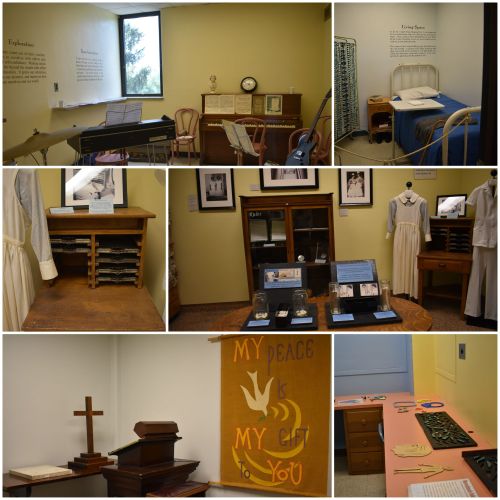
Top L-R: Music Therapy Room display and Patient Room display
Middle: Original Chart Desk and Psychiatric Nursing exhibit
Bottom: Spiritual Therapy display and Dexterity/Puzzle area
This large embroidered piece below was created by a patient with the nickname “The Tatterer.” She rarely spoke and was diagnosed as schizophrenic. I stood and solemnly read her words. The sign next to it read in part: “…her sewn words have been described as psychotic; but in 2010 new research found that the patient was very connected to her environment.” (“Silent Voice” description; Glore Psychiatric Museum, St. Joseph, Missouri.)

Throughout the museum there were displays and information about electroshock treatments, the history of lobotomies and other types of surgeries, rocking chair therapies, and the history of mental health treatments. A very tall container held empty, flattened cigarette packs that a patient had been hoarding. Another patient had been witnessed sticking a piece of paper into the back of a television set. Upon further investigation, the staff found over 500 notes written on pieces of paper inside the television.

Early type of straight-jacket
 This is a Restraint Ring – patients could be restrained to the wall
This is a Restraint Ring – patients could be restrained to the wall
with a chain if they were considered “out of control.” This Ring
was removed from the basement wall in the Center Building in 1980.
The basement held the original morgue and autopsy rooms as well as information about treatment and education for youth. These two cars were painted by youth patients and entered in a contest.

At one time, patients worked the land as a farm which brought in money to the hospital but then was thought that since the patients were working for so long, it was equal to slavery so the farm work was discontinued. At one time the hospital served over 3,500 people so large scale salad bowls were needed as well as the mixer stand in the photo below in order to mix dough or make other types of batter. This stand was about 5 feet tall.

We asked to tour “the tunnels” before we left. A member of the staff guided us outside and across the sidewalk to an adjoining building. The entryway looked as if it was having work done and an area was used as storage. She led us toward an open door. I kept walking but all I saw was a long, very dark tunnel. I backed up until she was able to turn the lights on. Both sides of the walls were covered with murals and paintings.

Patients had been led down there for art therapy. She told us to turn the lights out when we left. There were quite a few murals that – on a better surface and with better light – looked amazing. All I kept thinking was that I hoped the gated door halfway down the tunnel wouldn’t slam shut on us leaving us on the other side! I am not easily spooked but in that tunnel, I was a bit creeped out! We let her know when we were done.
The other smaller museums within those walls included the Black Archives Museum – highlighting St. Joseph African American experiences; the interactive Doll Museum; the Harry L. George Native American Collection which includes a large collection of artifacts from the late 1800s to early 1900s; and the WWI Saint Joseph: Reflections on Community and Conflict. There are also exhibits of the Folklore of Mary Alicia Owen and the Missouri Music Hall of Fame which includes Sheryl Crow and Chuck Berry.
The doll museum (which is one room) had a wall of Barbie dolls! I enjoyed looking at all the international Barbies.

Below is a display in the Native American area..

The display below has artifacts and information about the history of St. Joseph – especially about its founder, Joseph Robidoux IV. He had established a trading post in the Blacksnake Hills – now St. Joe.

Once finished at the Glore Psychiatric Museum, we went on to the motel and checked in. I cleaned up and then we went to eat at Bandanas Barbecue just down the road. One of my genealogy friends, Susan Petersen, always stops there on her way to Missouri from Nebraska so we had to try it. The food was excellent.

After relaxing at the motel after dinner for awhile, we drove on down to the Museum Hill Historic District. There are some beautiful churches and buildings. We parked behind a very large building in the Methodist Church parking lot.

The original location for the Francis Street First United Methodist Church was at 7th and Francis Streets and was built about 1857. Construction on the current building at 12th and Francis Streets began toward the late 1890’s-early 1900’s. We thought it was beautiful and wished we could look at the interior.

The building we parked behind had a dome at the top. As we walked to the front of it, my husband pointed out the words above it – First Church of Christ, Scientist. After doing some research later, I found that it was built in 1899 and has one of the largest pipe organs in the country. The congregation of the Christian Science church disbanded in the 1990s at that location, and it is now a wedding venue called The Dome.
In front of The Dome was a building that appeared to have been a church at one time. Now it is a Yoga Studio.

Across from the parking lot was the First Baptist Church and further down the block was Calvary Chapel.

Up on the hill was this large house with many steps going up to it.

Looking out toward St. Joseph, we saw a very long and huge structure that sat in the middle of Civic Center Park. The inscription over it said that it was given to the citizens of St. Joseph for Civic Use. Doing some research, we found that it was the City Hall built in 1926-1927. Another building I would have liked to see the inside.

We had a good first day in the city and were looking forward to the next.



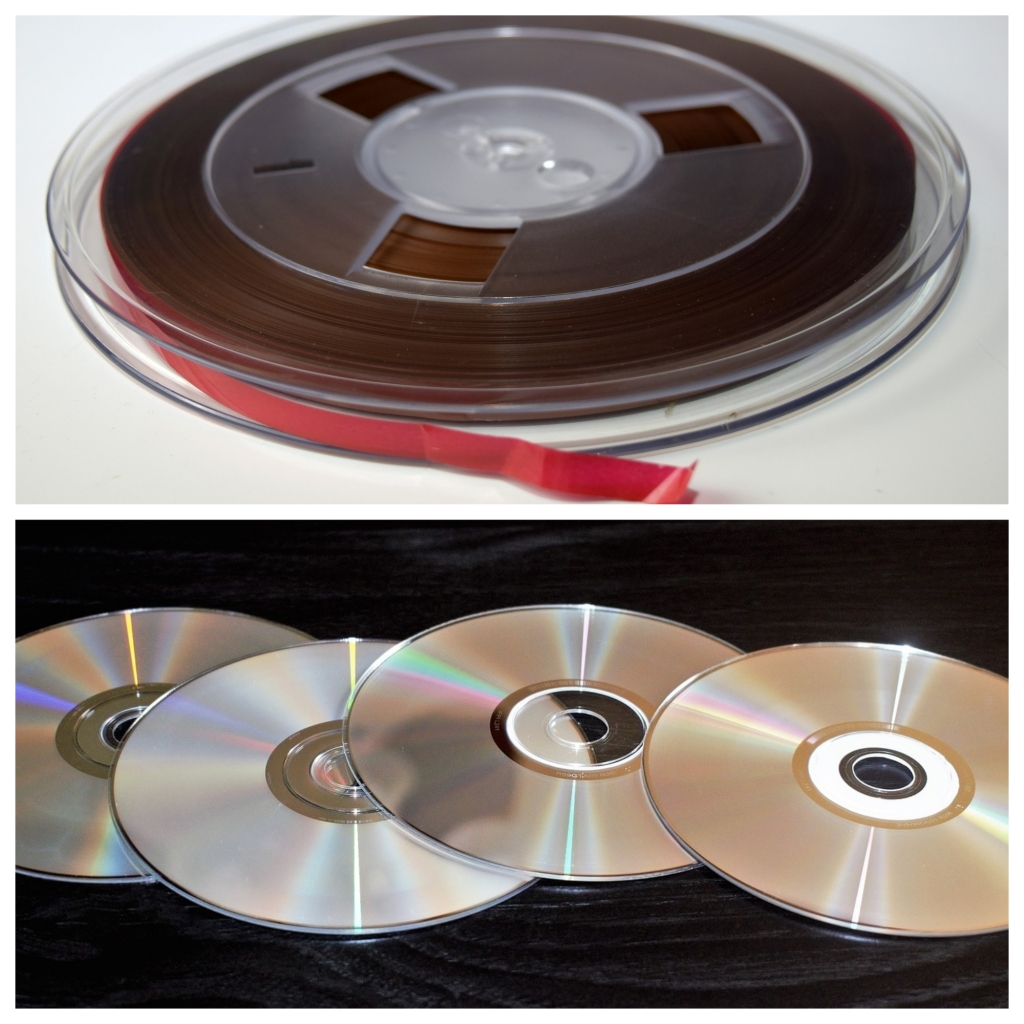



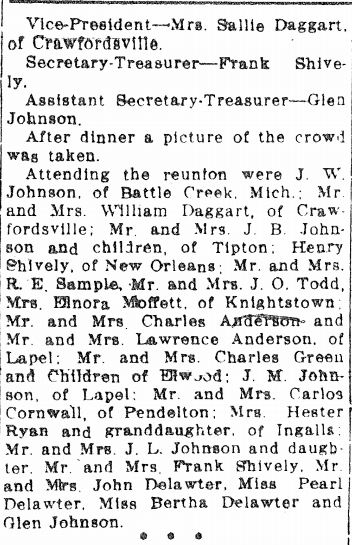




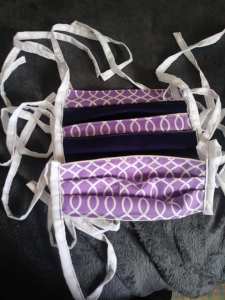





 Inside the wagons were bags of sugar and flour, mold to make candles, a chair, tools, a large pot, a jug, rope, a washboard, a grater, (this model has a) bottle of whiskey, other food-stuffs, bucket, bedrolls/blankets, and more items that were necessary for such a long journey.
Inside the wagons were bags of sugar and flour, mold to make candles, a chair, tools, a large pot, a jug, rope, a washboard, a grater, (this model has a) bottle of whiskey, other food-stuffs, bucket, bedrolls/blankets, and more items that were necessary for such a long journey.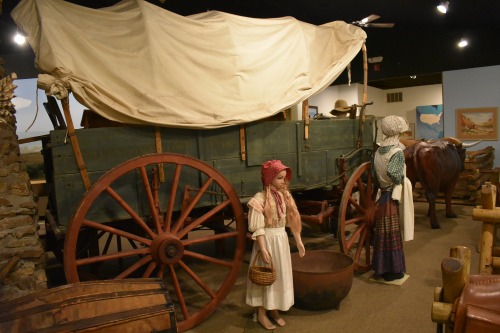











 This is a Restraint Ring – patients could be restrained to the wall
This is a Restraint Ring – patients could be restrained to the wall






















